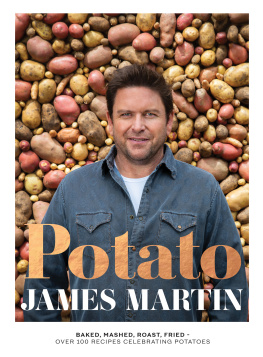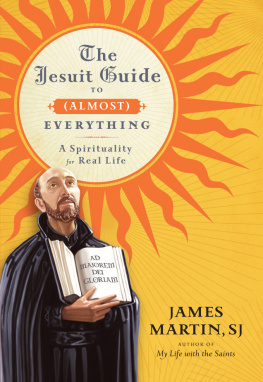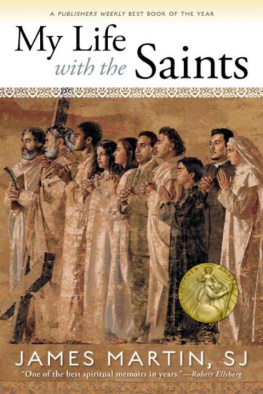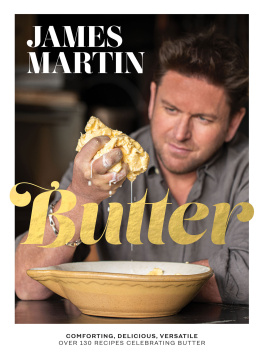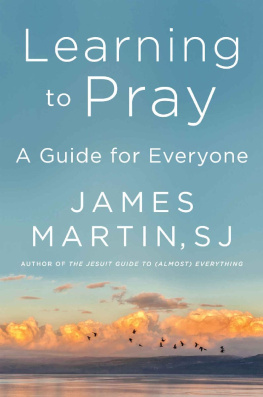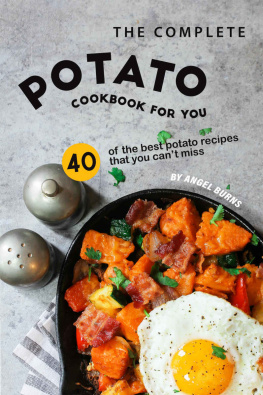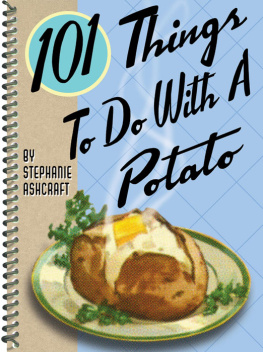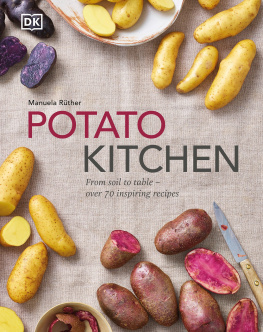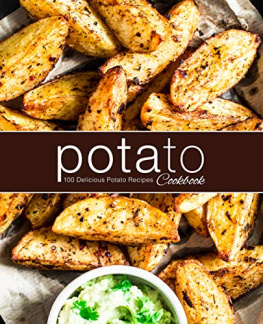
The worlds most popular vegetable is used by cooks around the globe, from high-end restaurants to simple fire pits. The versatility of the humble potato is vast, as is the number of recipes in which it can be used. There are over 5,000 types of potato, each with a specific texture, taste and use. Each is not only unique in flavour but in where and how it is grown. It wasnt until the 16th century that potatoes were introduced to Europe from South America, but they have quickly become a staple food, as they are in many other parts of the world today. Some of the greatest potatoes I have ever tasted come from Peru and Chile, where many wild varieties can be found.
Its amazing that the potato is now one of the most-produced crops in the world, alongside maize, wheat and rice. Once used as currency, many people take the unassuming potato for granted, but it can be as highly prized as any of the finest ingredients. Some varieties are so seasonal that they are available for just a few weeks of the year, like Jersey Royals, which can only be produced on a small island and are so special because of the combination of climate, soil and the type of potato. While others, such as the Marabel, which is one of my favourite baking potatoes, with a crispy skin on the outside and a creamy texture on the inside that almost tastes like butter, can be harvested and stored for up to a year. This cookbook explores different types of potato, from what makes a simple King Edward the best for roasting and an Estima not good for frying. Ill share what makes a great baking potato to the top choice for your fish and chips.
Not only that, but Ive combined over 100 recipes and techniques to guide you through a range of dishes from a pommes souffl served in the finest of restaurants to the perfect humble mashed potato. Theres everything from Tex-Mex BBQ filled potato skins to Japanese-inspired recipes where potatoes are baked in seaweed. Potatoes have been a constant presence in my cooking life, from the first time I stepped foot in catering college making classic game chips the accompaniment of choice for roast chicken and game birds to working in three-star Michelin restaurants cooking Pommes Anna, used in every form of cookery and a staple in many a classic French cookbook from Larousse Gastronomique to Le Rpertoire de La Cuisine. More recently, I have been involved in the running of SpudULike, the famous brand from the 1970s and 80s, which used to have queues round the block for their simple, but tasty, baked and filled potatoes. Its been great fun, not reinventing the brand but bringing it into the 21st century with a different twist, still keeping the classic taste at its core. This book is a progression from my last book, Butter, as both ingredients, probably more so with potatoes, can be found across the globe.
Their ability to grow in all manner of different climates is reflected in their use in an eclectic and international mix of recipes. Many of my mates who have Indian origins produce and cook some of my favourite food using humble ingredients like the potato, with the addition of a few spices, and whole dishes with wonderful flavours can be created for very little cost. Then you venture into the world of some of my other friends, like Clare Smyth and Sat Bains, both two- and three-star Michelin chefs, and see their trademark dishes using a simple single potato as the canvas for their food painting. In fact, Sat Bainss baked potato cooked in kombu and then in hot coals, opened up and topped with crme frache, butter and a dollop of caviar, creates two of the best-tasting mouthfuls of food you could wish for. Fish and chips are still the nations favourite, and rightly so. However, you wouldnt believe how technical the process can be to get the best fried chip, and I dont mean all that triple-cooked palaver.
Im talking about the extent some of the best fish and chip shops go to, to produce the great chip as we know it: it is a moving feast season by season, almost month by month, as they struggle to find the perfect potato with the right starch and sugar content to keep the standard the same. Everybody seems to think that they use the same potato all year round but that couldnt be further from the truth. The potato is probably the one ingredient that was the catalyst for me becoming a chef. I always remember my grandfather used to cook simple, boiled new potatoes with butter, and serve them with poached haddock in milk. The main reason these were so good is because he was a brilliant gardener, not only of roses, but of potatoes, both of which need a great soil and manure to grow. I remember each season we used to earth up or hill up, as he called it, and create 1015-foot mounds of earth, which had to be perfectly drawn with a string line, and put in the potatoes every 40 inches using an old measuring stick cut to size.
But it all paid dividends only a few months later when the crop decided to grow, as there is nothing that tastes as good as vegetables grown, dug and cooked the very same day. Potatoes are the ultimate field-to-fork ingredient, so enjoy and experiment with this collection of recipes celebrating this often overlooked kitchen staple. While you are reading this book, I am probably either cooking potatoes in my restaurant kitchen or planting potatoes in my garden. For me, they are the number one most-used vegetable, but what makes them fascinating is the different varieties and types of cooking methods they are good for. This book hopes to explore just a small percentage of what is a vast subject regarding one of the most popular ingredients in the world Enjoy it! 




FOCACCIA WITH POTATOES AND ROSEMARY

SERVES 8
This bread dough not only looks and tastes fantastic, but it is easy to make, too. The most important thing to remember is that you must make the dough quite wet and sticky and knead it for a decent amount of time I usually do it for ten minutes.
Once out of the oven, you can brush the focaccia with even more olive oil. Use extra virgin olive oil to dip it into, as this has a better flavour.500g strong bread flour7g sachet fast-action yeast1 tablespoon salt100ml olive oil, plus extra for greasing350400ml lukewarm water400g new potatoes, cooked and sliceda few sprigs of rosemary, choppedextra virgin olive oil, for dipping In a stand mixer, mix the flour, yeast and salt with half the oil and lukewarm water. Using the dough hook, knead the dough for 510 minutes it should be sticky. Oil a shallow rectangular baking tray. Drop the dough in and stretch out to the corners. Leave to prove for 1 hour.
Preheat the oven to 220C (200C fan)/425F/gas 7. Dot the dough with the potatoes and rosemary and drizzle over the remaining oil. Bake for 20 minutes until the dough and potatoes are golden. Serve with extra virgin olive oil for dipping. 
Next page
